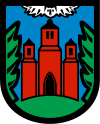Twardogóra
| Twardogóra | |||
|---|---|---|---|
| |||
 Twardogóra | |||
| Coordinates: 51°21′53″N 17°28′11″E / 51.36472°N 17.46972°E | |||
| Country |
| ||
| Voivodeship | Lower Silesian | ||
| County | Oleśnica | ||
| Gmina | Twardogóra | ||
| Area | |||
| • Total | 8.29 km2 (3.20 sq mi) | ||
| Population (2006) | |||
| • Total | 6,866 | ||
| • Density | 830/km2 (2,100/sq mi) | ||
| Postal code | 56-416 | ||
| Website | http://www.twardogora.pl | ||
Twardogóra [tfardɔˈɡura] (formerly Old Polish: Twarda Góra (Hard Mountain), German: Festenberg) is a town in Oleśnica County, Lower Silesian Voivodeship, in south-western Poland. It is the seat of the administrative district (gmina) called Gmina Twardogóra.
The town was first mentioned as Vestenberg in a document dated 1 September 1293 as a trading place at the road from Wrocław to Poznań. In the 14th century, as part of the Duchy of Oels, it was transferred to the Kingdom of Bohemia, which became part of the Habsburg monarchy in 1526. the town adopted Lutheranism in 1538.In 1742 Silesia became Prussian and remained within Germany until 1945. On 23 January 1945 the town was taken by the Red Army. A baroque palace was burned to the ground in 1947.
It lies approximately 20 kilometres (12 mi) north of Oleśnica, and 40 kilometres (25 mi) north-east of the regional capital Wrocław.
As at 2006, the town has a population of 6,866.
People
- Ludwig Laqueur (1839–1909), German ophthalmologist
- Paul Grützner (1847-1919), German physiologist
- Hagen Kleinert (born 1941), German physicist
External links
- Official website
- Old postcard of Festenberg
- Jewish Community in Twardogóra on Virtual Shtetl
| Wikimedia Commons has media related to Twardogóra. |
Coordinates: 51°21′53″N 17°28′11″E / 51.36472°N 17.46972°E

